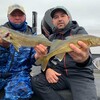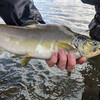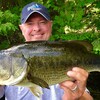Fall Walleye: Chub, Bottom Bouncers and Beads

Fall walleye fishing is one of the more enjoyable pastimes an angler can experience. In many of Northern Ontario's most popular lakes, the crowds are gone and the boat launches are empty. It's not like the fish have gone anywhere, though. They are still swimming around looking for food. The good news for the angler is that walleye in the fall are hungrier than ever as winter approaches and bugs and minnows become more scarce.
Fall Walleye Location
Walleye in the fall are generally going to be found in slightly deeper water than they were through the summer. This is a general rule, as all lakes are different. However, I always start my search for fall walleye around mid-lake reefs, humps and at the base of drop-offs. Good electronics really help the underwater search, as you should be able to mark the fish on bottom. I recommend using the zoom function to get a close look at the bottom 10 feet, where almost all walleye will be found. They will show on the unit as half hooks or bumps on the bottom.
In October and early November, I've found walleye are often found in between 20 and 30 feet of water. If you find the specific depth the fish are at, you can locate them in other parts of the lake at the same depth. If you do locate walleye, make sure you mark them with a GPS waypoint if you have that capability. It makes them—and the structure they are on—way easier to return to. I also throw a marker buoy over the side to have a visual marker on the surface while I fish. If there is a reef or structure nearby, throw a marker on the shallowest top of it as well. Having markers on the surface of the water will help the brain interpret what I am seeing on my depth sounder. Other fall walleye locations can include windswept, rocky shorelines, deep points, and river inlets. Finding fish is always the hardest part of fall walleye fishing, but when I do, they are generally receptive.
Catching Fall Walleye With Bait
One of the very best ways to catch walleye in the fall is with a big, fat minnow. Walleye just can't seem to resist leaping on a 4-inch chub or sucker minnow that is slowly pulled by. The bait needs to be presented very close to the bottom, as that's where almost all the fish will be. Because large minnows on a hook have to be grabbed and then at least partially swallowed by the fish, you need some time to let this happen.
The two best presentations that allow for this to happen are via a bottom bouncer or slip sinker rig. Both are weights that pull a minnow, hook and coloured bead along bottom. The bead acts as an attractor and should be placed on the line directly in front of the bait. I've had good luck with green, red and blue beads, but it never hurts to experiment. The Creek Candy Bead Company makes some sweet beads that have a lot of unique colour choices. Hooks should be on the larger side and sharp. Octopus hooks of size #1 or #2 are the best with larger bait. Hook bait through the lips so the minnow can swim freely.

Bottom Bouncer
The bottom bouncer is a very basic weight that is just a heavy weight on a bent piece of wire. The vertical wire has the weight attached and slides along bottom. The other end of the wire has a swivel, and this is where a monofilament leader of 2 or 3 feet (or more) is tied. The main line from your reel is tied at the bent elbow of the bottom bouncer. You keep the weight on bottom and as vertical to the boat as possible. Fishing the bottom bouncer with a bait caster reel and a long, medium-action fishing rod allows you to easily adjust the depth and watch for hits via the rod tip. When the rod tip starts to pull back, let the fish take the bait until the top nears the water's surface. Then sweep the rod forward to set the hook.
Slip Sinker Rig
The slip sinker rig is ingenious in its simplicity. The sinker has a hole in it, and the line slips through it when the walleye takes the minnow. Some of the slip sinker types include the walking sinker and the No Snagg Sinker. The trick with a slip sinker is that you need to have a bead and swivel placed between the hook and bead to keep the sinker from sliding the wrong way. You put the slip sinker on the main line, followed by a bead and a barrel swivel. Then, 3 to 4 feet of line is attached to the swivel with another bead and then the hook. A good rule of thumb is to make the leader a couple of pounds less than the main line. Troll slowly with the slip sinker bumping bottom and keep the bail open on your reel, but the line presses against the rod blank. When you feel a pick-up, let the line go and stop trolling. The walleye will swim with the minnow, and hopefully take it into its mouth deeply enough, the hook will be in striking position. Close your bail, reel up slack till you feel the fish on your line and set the hook. There are few feeling better than the solid thump of a big walleye.
Bait
Large minnows are the key to this fall technique. A chub of 4 to 5 inches will get the attention of nearly any walleye. In the same way, a sucker minnow will call in a giant walleye. I've used sucker minnows of up to 6 inches, but you need to use a very large hook and be patient when a fish takes it. That's a lot of meat!

Fall walleye fishing is a great activity and can provide some of the best action of the season. With the techniques outlined here, you should be well-equipped to fill a live-well with some autumn gold.
Recommended Articles

World Class Walleye
Adventure Walleye Fishing Lake Nipigon Style
Catching Ontario Walleye

A Guide to Fly-in Ontario Lodges

Rigged for Ice Fishing Success

Lakers of Lower Manitou: Fishing Just North of the U.S. Border

Multi-Species Action
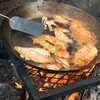
How to Make a Fish Shore Lunch

Talon Lake Lunge

Top 5 Flies for Smallmouth Bass

How to: Target Black Crappies (Part 1)

3 Great Ontario Walleye Destinations
Fishing and Foraging

Pine Sunset Lodge
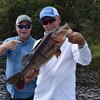
Polarized Sunglasses

Cedar Lake Showdown
Remote and Unique Lodges in Ontario

Cast Back for Giant Muskies

Ten Mile Lake Lodge





